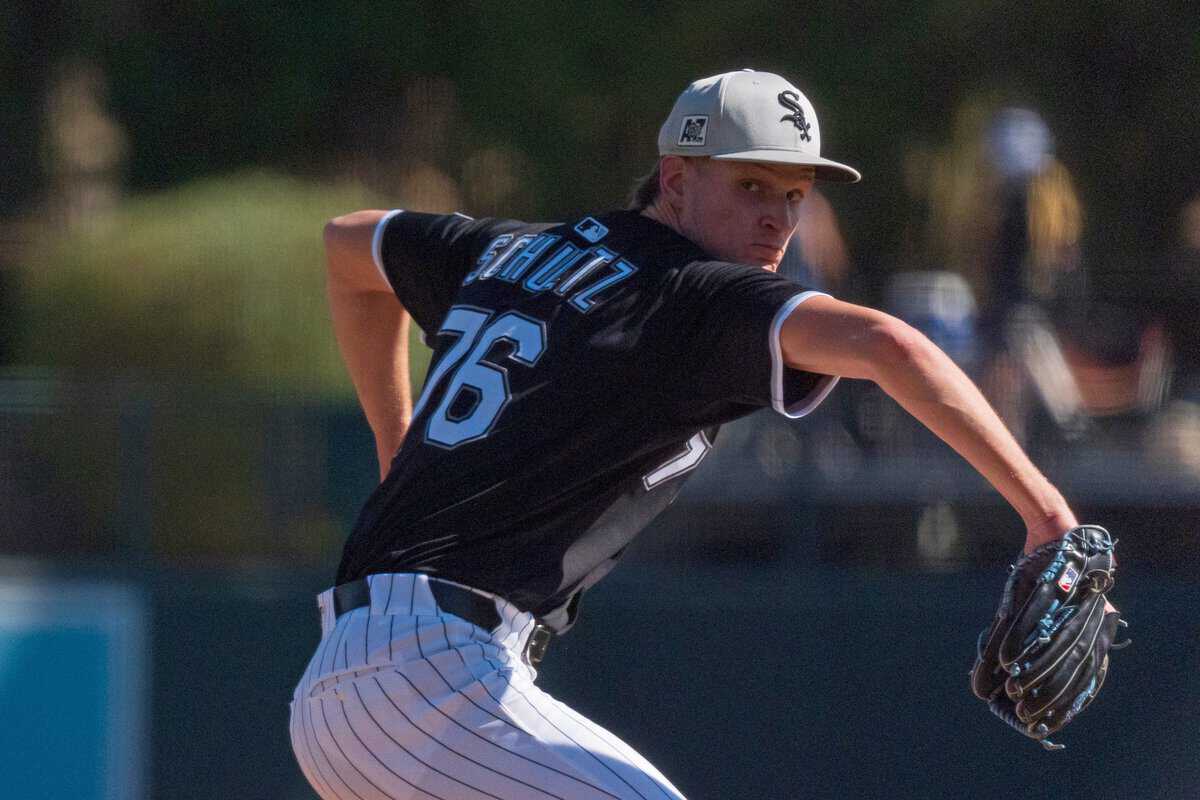Whenever the White Sox finalize their Opening Day 26-man roster after making all necessary adjustments to their 40-man, it will invariably include a player outside the several dozen this exercise will mention, and I'm prepared to wear that shame.
In the meantime, here's an acknowledgment of an unforced error from the front half of this series: I forgot to re-rank Chase Meidroth after his optioning to Charlotte. He's now 27th, in between Bryan Ramos and Jairo Iriarte. Sox Machine regrets the oversight.
No. 20: Shane Smith (NA)
Expectations should be muted for a Rule 5 pick, but what if the Rule 5 pick shows up throwing three ticks harder with a changeup that wasn't in his grasp last year? The biggest reason to check enthusiasm is that he hasn't yet thrown 100 innings in a professional season. The gains seem real; whether he can sustain them is the question.
No. 19: Austin Slater (NA)
Slater said the White Sox told him he was their "top target" when they agreed to terms in November, and while that's probably only true under a highly restrictive set of criteria, it's probably in the team's interest to have that reflected by the kind of cromulent outfield play the depth chart has sorely lacked in previous years. He only amassed 25 plate appearances in Cactus League play due to an oblique injury.
No. 18: Brooks Baldwin (NR)
It's still weird to me that Baldwin floated around various defensive positions during spring training while the White Sox's preferred options at shortstop faltered for one reason or another. He had a decent showing in the spring (.250/.313/.409) and struck out only five times over 49 plate appearances, but the White Sox seem intent with sticking the utility label on him for the time being.
No. 17: Matt Thaiss (NA)
No. 16: Korey Lee (24)
The idea is that the White Sox's two catchers at the start of the season won't be their two catchers at the end of the season, but Thaiss and Lee have enough latent potential to delay the inevitable. Until the torch is passed, they'll be counted upon to deliver improved receiving to help the pitchers, and perhaps form an effective-enough pseudo-platoon as well.
No. 15: Lenyn Sosa (39)
Watching Sosa hit over the last two months of the 2024 season, then carry it over into winter ball and spring training, I have the sense that he's like Walmart stock: a place to put your money when everything else is going to hell.
No. 14: Josh Rojas (NA)
The hairline fracture in his toe sets an ominous tone for the start of his White Sox career, but he'll still be counted upon to help fortify the infield, which is short of plus defenders at any position.
No. 13: Martín Pérez (NA)
On a team like this, Chris Flexen more or less provided the template in terms of production, and the eradication of the White Sox's high-minors starting depth made any and all reliability a little more important. He's also providing the veteran ballast for an otherwise inexperienced rotation, so perhaps some valuable life lessons will be imparted.
No. 12: Andrew Vaughn (4)
It's hard to see meaningful upside since he only has one more arb year remaining and the White Sox are years away from having enough to compete. Still, he'll be in the lineup until he isn't, and his hot streaks make the lineup more watchable.
No. 11: Jonathan Cannon (NR)
A rocky spring reminds that his arsenal is still in search of a final form, but even if he ends up getting surpassed by the pitchers listed ahead of him, it's crucial that he remains a part of the near-term rotation plans. Otherwise, it gets grisly pretty quickly.
No. 10: Andrew Benintendi (9)
He reached 20 homers for the second time in his career despite everything else going wrong with and around him in 2024, and he had a near-.900 OPS over the final two months. The non-displaced right hand fracture he suffered early in Cactus League play runs the risk of resetting that work, but if he's able to resume that form with enough time before the trade deadline, perhaps he could generate some interest from teams seeking a left-handed bat.
No. 9: Sean Burke (NR)
No. 8: Davis Martin (41)
You can flip the order if you prefer the upside, but Martin has thrown more than 140 innings in two other professional seasons, is 28 years old, and should be ready to let loose after a full, healthy offseason. Burke is three years younger and hasn't even thrown 110 innings in a season, so Martin might be the stabler presence.
No. 7: Miguel Vargas (NA)
The concern was that Vargas would be handed a starting job purely due to his lack of options, but he earned the playing time with his Cactus League performance while the other options crumbled around him, so that's a temporary relief. Now comes the regular season, where even average production would show that both Vargas, coaches, and others on the player development staff have an ability to right the ship.
No. 6: Colson Montgomery (2)
In terms of setting appropriate expectations, it's probably best for everybody that Montgomery will start the season in Charlotte instead of Chicago, because it was hard to envision an Opening Day assignment succeeding, especially after back spasms entered the chat. Assuming he's structurally sound, Montgomery is still the White Sox's best potential source of power and patience, and patience will likely be required to see it through to its final form against MLB pitching.
No. 5: Hagen Smith (NA)
Smith doesn't need to reach the majors or anything this year, but after the White Sox failed to generate meaningful major league production from their last two top-five picks, it's pretty important for Smith to generate excitement at whatever level he's pitching.
No. 4: Edgar Quero (21)
No. 3: Kyle Teel (NA)
Paul Janish said they'll be sharing time behind the plate and at DH in Charlotte, and both are close enough to the majors that either could be the primary catcher in July. Teel being the primary player acquired in the return for Garrett Crochet makes his success a little more important to the idea that this front office can correctly appraise talent.
No. 2: Noah Schultz (NR)
He's basically in the same situation as Smith with regards to major league proximity, but given that he's already experienced success at Birmingham, he has a better argument for ascending earlier.
No. 1: Luis Robert Jr. (1)
If Robert's right, he's the White Sox's most reliable source for genuine baseball thrills, and if Robert carries it into July, he figures to have considerably more trade value to put a jolt into the deadline period as well. At some point, the middle of the summer will arrive and the White Sox won't be talking about trading their good players, but 2025 is not that year.





